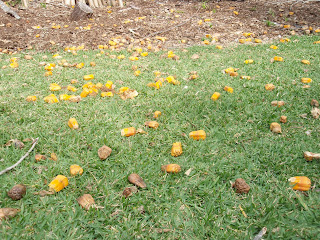On our first trip to northern Australia many years ago, my attention was caught by the numerous palm-like trees that seemed to be bearing crops of pineapples. I remember lazily observing them through the car window and wondering about them. I didn't think pineapples grew on trees, but had never been to the subtropics before and was willing to believe there was an arboreal variety that we ignorant southerners were unaware of.
Pandanus trees make interesting architectural features in northern gardens. Clusters of long strappy leaves wave in the wind at the tops of multi-branching trunks supported by stilt roots. The large fruits turn from green to bright yellow and glow amidst the palm-like foliage. An added feature is the attractive texture of the trunks, especially in young trees. We admired some with raised circular bands in different shades of brown, which I was compelled to stroke.




No comments:
Post a Comment